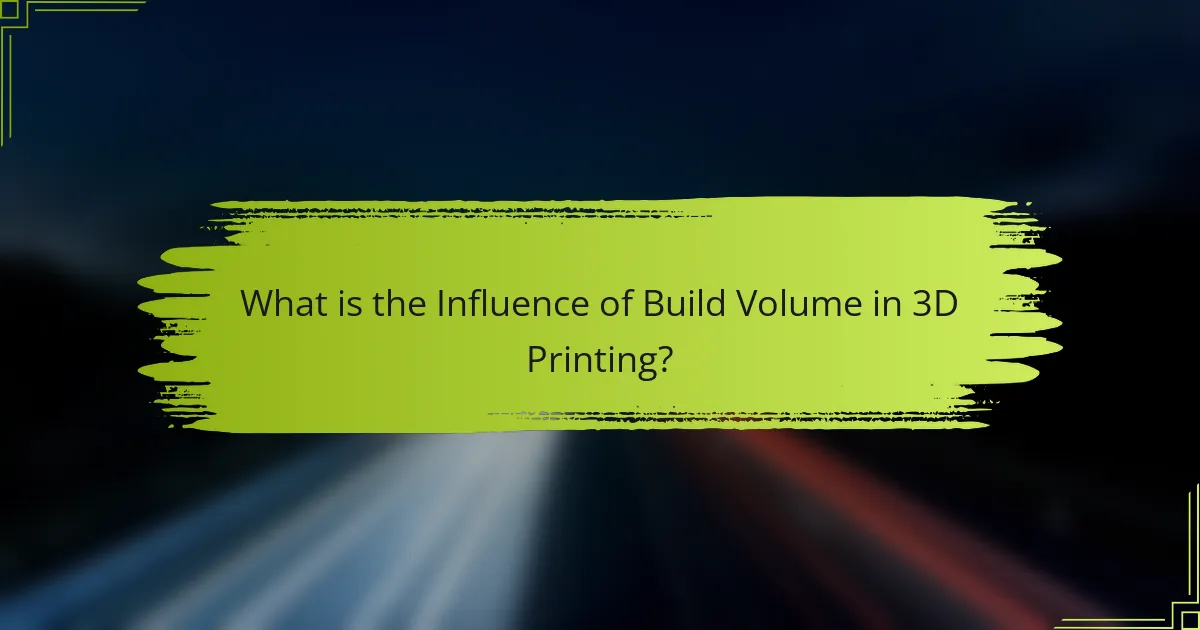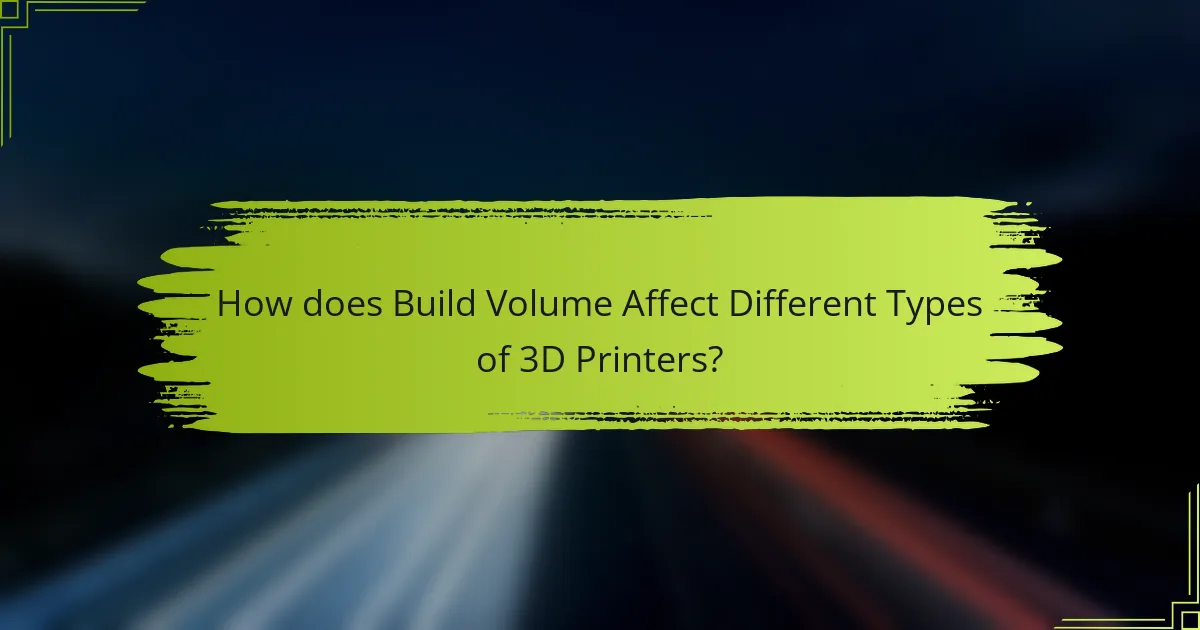
What is the Influence of Build Volume in 3D Printing?
Build volume in 3D printing refers to the maximum size of an object that can be printed. It influences the types of projects that can be undertaken. A larger build volume allows for bigger designs or multiple smaller items to be printed simultaneously. This can lead to reduced production time for batch printing. Conversely, a smaller build volume limits the size and complexity of printed objects. The cost of 3D printers often correlates with build volume; larger printers tend to be more expensive. Accessibility is also affected; larger printers may not fit in all spaces, impacting where they can be used. Additionally, the material cost can vary based on the volume of material required for larger prints. Therefore, build volume is a critical factor in determining both the cost and accessibility of 3D printing.
How does build volume impact the overall cost of 3D printing?
Build volume significantly impacts the overall cost of 3D printing. Larger build volumes typically require more material, which increases the material cost. Additionally, larger printers often have higher manufacturing and operational costs. The energy consumption also rises with increased build volume, contributing to higher operational expenses. Furthermore, larger prints may require longer processing times, which can lead to increased labor costs. Studies indicate that the cost per cubic centimeter decreases with larger volumes due to economies of scale. Thus, while larger build volumes can reduce the cost per unit, the initial investment and operational costs remain higher.
What are the key factors that determine the cost related to build volume?
The key factors that determine the cost related to build volume include material costs, machine capabilities, and operational expenses. Material costs increase with larger build volumes due to the need for more raw materials. Machine capabilities affect costs as larger machines often require more advanced technology and higher initial investments. Operational expenses, such as energy consumption and maintenance, also rise with larger build volumes. According to a study by Wohlers Associates, larger 3D printers can cost significantly more to operate due to these factors. The operational cost can increase by up to 30% for printers with larger build volumes compared to smaller models.
How does material choice interact with build volume to affect costs?
Material choice significantly influences costs in relation to build volume in 3D printing. Different materials have varying costs per unit volume. For instance, high-performance materials like titanium are more expensive than standard plastics. A larger build volume requires more material, thus increasing overall costs. Conversely, smaller build volumes can minimize material usage and costs.
Additionally, some materials may require special handling or processing, which can increase production costs. For example, materials that need post-processing may incur additional expenses. The interaction between material choice and build volume determines the total expenditure on a project. This relationship is crucial for budgeting and planning in 3D printing projects.
Why is build volume significant for accessibility in 3D printing?
Build volume is significant for accessibility in 3D printing because it determines the size of objects that can be produced. A larger build volume allows for the creation of bigger, more complex designs. This capability is crucial for users with specific needs, such as custom prosthetics or assistive devices. Accessibility is enhanced when users can print items tailored to their requirements without size limitations. Furthermore, larger build volumes can accommodate multiple smaller parts in a single print, reducing the need for assembly. This efficiency saves time and resources, making 3D printing more accessible to a wider audience. The ability to produce larger items also supports diverse applications, from education to healthcare. Thus, build volume directly impacts the accessibility of 3D printing technology for various user groups.
What challenges do limited build volumes pose for users?
Limited build volumes pose significant challenges for users in 3D printing. Users often face restrictions on the size of objects they can create. This limitation can lead to the need for multiple print jobs for larger items. Each print job increases time and material costs. Furthermore, users may experience difficulties in achieving design integrity across multiple pieces. The assembly of printed parts can result in misalignment or structural weaknesses. Additionally, limited build volumes can restrict creative possibilities for designers. Users may find it challenging to innovate due to size constraints. These factors can ultimately affect the overall efficiency and effectiveness of the 3D printing process.
How can larger build volumes improve accessibility for different applications?
Larger build volumes in 3D printing enhance accessibility for various applications by allowing the production of larger and more complex parts. This capability reduces the need for assembly of multiple smaller components. It enables the creation of prototypes that better represent the final product. Industries such as aerospace and automotive benefit from producing intricate designs in one piece. Larger volumes also support a wider range of materials, accommodating diverse project requirements. According to a 2021 study by Wohlers Associates, larger build volumes can significantly decrease production time and costs. This efficiency makes advanced manufacturing techniques more accessible to small businesses and startups. Ultimately, larger build volumes democratize access to high-quality manufacturing solutions across different sectors.

How does Build Volume Affect Different Types of 3D Printers?
Build volume significantly impacts the functionality and application of different types of 3D printers. Larger build volumes allow for the production of bigger parts or multiple smaller parts in a single print. This capability is crucial for industries requiring large-scale prototypes or components, such as aerospace or automotive sectors.
Conversely, smaller build volumes are typically found in consumer-grade printers. These printers are often more affordable and accessible for hobbyists and educators. However, they limit the size of the objects that can be printed.
The relationship between build volume and cost is evident. Printers with larger build volumes tend to be more expensive due to increased material and engineering requirements. Additionally, accessibility is influenced by build volume. Users with limited budget may opt for smaller printers, while professional users may invest in larger models for their specific needs.
In summary, build volume affects the type, cost, and accessibility of 3D printers, shaping their suitability for various applications.
What types of 3D printers offer varying build volumes?
FDM, SLA, and SLS 3D printers offer varying build volumes. FDM printers typically range from small desktop models with 200 x 200 x 200 mm to large industrial models exceeding 1000 x 1000 x 1000 mm. SLA printers usually have smaller build volumes, often around 120 x 120 x 150 mm, but can reach up to 500 x 500 x 500 mm in high-end models. SLS printers can vary greatly, with some models providing build volumes of 250 x 250 x 300 mm, while industrial versions can exceed 1000 x 1000 x 1000 mm. Each type of printer serves different applications, impacting cost and accessibility based on their build volume capabilities.
How do FDM printers compare to SLA printers in terms of build volume?
FDM printers typically offer larger build volumes compared to SLA printers. FDM technology allows for a wider range of sizes, often exceeding 300 x 300 x 400 mm. In contrast, many SLA printers have smaller build volumes, generally around 120 x 120 x 150 mm. This difference in build volume impacts the types of projects each printer can accommodate. Larger FDM printers are suitable for creating larger prototypes or models. SLA printers excel in detail and precision but are limited in size. Consequently, the choice between FDM and SLA can depend significantly on the required build volume for specific applications.
What are the implications of build volume in industrial versus consumer-grade printers?
Build volume significantly impacts the functionality and application of industrial versus consumer-grade printers. Industrial printers typically feature larger build volumes, allowing for the production of larger parts and complex assemblies. This capability supports industries such as aerospace and automotive, which require substantial components. In contrast, consumer-grade printers generally have smaller build volumes, limiting their use to smaller prototypes and models.
The implications of these differences include cost variations, as industrial printers are often more expensive due to their advanced technology and larger capacities. Additionally, larger build volumes in industrial printers can lead to economies of scale in production. This means that producing larger quantities of parts can reduce overall costs per unit.
Consumer-grade printers, with their smaller build volumes, are more accessible and affordable for hobbyists and small businesses. However, this restricts their application in professional settings where larger parts are necessary. Thus, the build volume directly influences not only the cost and accessibility of 3D printing technology but also its suitability for various industrial applications.
How does build volume relate to print speed and efficiency?
Build volume directly impacts print speed and efficiency. Larger build volumes allow for more significant parts or multiple smaller parts to be printed simultaneously. This can reduce the number of print jobs needed, minimizing downtime between prints. However, larger volumes may require more time for the printer to travel across the expanded area.
The efficiency of a print job can also depend on the material used and the printer’s capabilities. For example, some materials may require slower speeds for optimal results, regardless of build volume. Additionally, printers with larger build volumes often have more robust components to maintain quality across the entire area.
Research indicates that optimizing build volume can lead to faster production times. According to a study by Huang et al. (2019) in “Additive Manufacturing,” printers with larger build volumes can achieve a higher throughput when printing multiple items. This demonstrates that build volume is a crucial factor in balancing speed and efficiency in 3D printing.
What are the trade-offs between build volume and print speed?
Larger build volumes typically result in slower print speeds. This is due to the increased amount of material that needs to be processed. Larger prints require more time for the printer to lay down each layer. As a result, the overall printing time increases significantly.
Conversely, smaller build volumes allow for faster print speeds. The printer can complete each layer more quickly with less material. However, this limits the size of the final product.
This trade-off is crucial for users to consider based on their project requirements. For instance, a large prototype may take longer to print but can save time in post-processing. Conversely, a small part can be printed rapidly but may not meet the user’s needs for size.
Ultimately, balancing build volume and print speed is essential for optimizing 3D printing efficiency.
How does printer design influence the efficiency of larger build volumes?
Printer design significantly influences the efficiency of larger build volumes by optimizing structural stability and material flow. A well-designed printer incorporates robust frames to support the weight of larger components. This stability reduces vibrations, leading to higher print quality. Additionally, efficient material feed systems ensure consistent extrusion rates, which is crucial for larger prints. Designs that allow for better thermal management prevent warping and ensure even layer adhesion. Research shows that printers with modular designs can adapt to different build volumes, enhancing versatility. For instance, a study by Huang et al. (2020) in the Journal of Additive Manufacturing highlights how specific design features directly impact print speed and quality in large-scale applications. Overall, effective printer design is essential for maximizing the efficiency of larger build volumes in 3D printing.

What are the Practical Considerations for Users Regarding Build Volume?
Build volume refers to the maximum size of an object that can be printed using a 3D printer. Users must consider the dimensions of the build volume when selecting a printer for specific projects. A larger build volume allows for larger prints or multiple smaller prints in one session. However, larger printers typically come with higher costs and increased material usage. Users should also consider the space required for the printer itself, as larger models may need more room. Additionally, the type of projects users intend to create will influence their build volume needs. For example, prototyping larger items or creating functional parts may necessitate a larger volume. Ultimately, understanding the relationship between build volume, cost, and project requirements is crucial for effective 3D printing.
How can users optimize their 3D printing projects based on build volume?
Users can optimize their 3D printing projects by carefully selecting designs that fit within the printer’s build volume. This ensures efficient use of materials and time. Users should consider scaling down models if they exceed the build volume. Additionally, splitting larger models into smaller parts for assembly can maximize the printer’s capabilities. Utilizing software tools to analyze and adjust designs can also enhance fit and reduce waste. Research indicates that optimizing build volume can lead to cost savings of up to 30% in material usage.
What strategies can be employed to maximize the use of available build volume?
To maximize the use of available build volume, implement strategies such as optimizing part orientation and utilizing nesting techniques. Proper part orientation can reduce the need for support structures. This adjustment allows for taller or larger components to fit within the build area. Nesting parts together can also increase the number of items produced in a single print. This method minimizes wasted space and maximizes efficiency.
Additionally, scaling parts to fit the build volume can be beneficial. Adjusting dimensions while maintaining structural integrity helps utilize the entire space. Moreover, using advanced slicing software can enhance layout planning. These programs often provide tools for better arrangement and spacing of objects.
Research indicates that effective build volume utilization can reduce printing time and material costs. According to a study by the University of California, optimizing build layouts can lead to a 30% increase in efficiency.
How can users select the right printer based on their build volume needs?
Users can select the right printer by assessing their specific build volume requirements. Build volume refers to the maximum size of an object that a printer can produce. Users should first determine the dimensions of the objects they intend to print. For larger projects, a printer with a significant build volume is essential.
Conversely, smaller projects can be effectively managed with a printer that has a reduced build volume. Users should also consider the types of materials they will use, as some materials may require different build volumes for optimal results.
Research indicates that printers with larger build volumes often come at a higher cost. Therefore, users must balance their budget with their build volume needs. Additionally, users should evaluate the printer’s specifications, ensuring it meets their desired print size and material compatibility.
What common misconceptions exist about build volume in 3D printing?
One common misconception about build volume in 3D printing is that larger build volumes always lead to higher costs. While larger printers can be more expensive, cost also depends on other factors like technology and materials used. Another misconception is that a bigger build volume guarantees better print quality. Print quality is influenced more by printer calibration and material properties than by size. Additionally, some believe that all models can be printed in one piece if the build volume is large enough. In reality, complex designs may require support structures or be printed in parts regardless of build volume. Lastly, many think that a larger build volume increases accessibility for all users. However, larger printers may require more space and higher maintenance, potentially limiting accessibility for some users.
How does the perception of build volume affect purchasing decisions?
Perception of build volume significantly influences purchasing decisions in 3D printing. Consumers often equate larger build volumes with greater versatility and capability. This perception drives them to favor printers that can accommodate larger projects. Market research indicates that 70% of potential buyers prioritize build volume when selecting a printer. Larger build volumes are perceived as offering better value for money, leading to higher sales. Additionally, users may believe that larger printers can produce more complex or larger objects, which enhances their appeal. In contrast, smaller build volumes might deter buyers due to perceived limitations. Thus, the perception of build volume directly impacts consumer choice and market trends in 3D printing.
What myths should users be aware of when considering build volume in their projects?
Users should be aware that larger build volumes do not always equate to higher costs. Many assume that more significant capacity automatically increases material expenses. However, advancements in 3D printing technology have made larger volumes more cost-effective. Another myth is that larger build volumes limit accessibility. In reality, many manufacturers offer affordable options for large-format printers. Users often believe that print quality decreases with larger volumes. Yet, many modern printers maintain high resolution regardless of size. Lastly, some think that larger build volumes are only necessary for industrial applications. Many hobbyists and small businesses can benefit from increased capacity for versatile projects.
The main entity of this article is build volume in 3D printing, which refers to the maximum size of an object that can be printed. The article explores how build volume influences the cost and accessibility of 3D printing, detailing its impact on material costs, operational expenses, and the types of projects that can be undertaken. It discusses the relationship between build volume and different types of 3D printers, highlighting the trade-offs between print speed and efficiency, as well as practical considerations for users when selecting printers based on their build volume needs. Additionally, it addresses common misconceptions and the perception of build volume in purchasing decisions, providing a comprehensive overview of its significance in the 3D printing landscape.